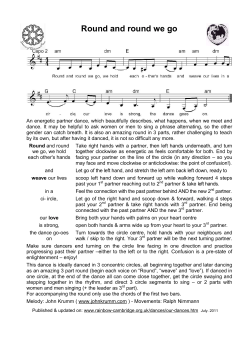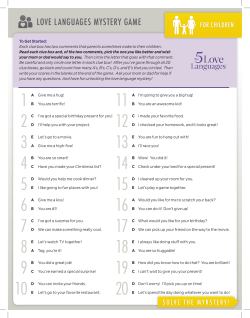
10.7 Locus What
Page 1 of 7 10.7 What you should learn GOAL 1 Draw the locus of points that satisfy a given condition. GOAL 2 Draw the locus of points that satisfy two or more conditions. Why you should learn it RE FE To use real-life constraints, such as using seismograph readings to find an epicenter in Example 4 and Ex. 29. AL LI Locus GOAL 1 DRAWING A LOCUS SATISFYING ONE CONDITION A locus in a plane is the set of all points in a plane that satisfy a given condition or a set of given conditions. The word locus is derived from the Latin word for “location.” The plural of locus is loci, pronounced “low-sigh.” A locus is often described as the path of an object moving in a plane. For instance, the reason that many clock faces are circular is that the locus of the end of a clock’s minute hand is a circle. EXAMPLE 1 Finding a Locus Draw point C on a piece of paper. Draw and describe the locus of all points on the paper that are 3 inches from C. SOLUTION C In ancient China, a seismometer like this one could measure the direction to an epicenter. 1 C Draw point C. Locate several points 3 inches from C. 2 Recognize a pattern: the points lie on a circle. C 3 Draw the circle. The locus of points on the paper that are 3 inches from C is a circle with center C and a radius of 3 inches. CONCEPT SUMMARY FINDING A LOCUS To find the locus of points that satisfy a given condition, use the following steps. . . .1. . .Draw . . . . any figures that are given in the statement of the problem. 2 Locate several points that satisfy the given condition. Continue C O3N C E 4 642 Chapter 10 Circles drawing points until you can recognize the pattern. Draw the locus and describe it in words. Page 2 of 7 GOAL 2 LOCI SATISFYING TWO OR MORE CONDITIONS To find the locus of points that satisfy two or more conditions, first find the locus of points that satisfy each condition alone. Then find the intersection of these loci. EXAMPLE 2 Logical Reasoning Drawing a Locus Satisfying Two Conditions Points A and B lie in a plane. What is the locus of points in the plane that are equidistant from points A and B and are a distance of AB from B? SOLUTION D A B A B A B E The locus of all points that are equidistant from A and B is the perpendicular bisector Æ of AB. EXAMPLE 3 The locus of all points that are a distance of AB from B is the circle with center B and radius AB. These loci intersect at D and E. So D and E are the locus of points that satisfy both conditions. Drawing a Locus Satisfying Two Conditions Point P is in the interior of ™ABC. What is the locus of points in the interior of ™ABC that are equidistant from both sides of ™ABC and 2 inches from P? How does the location of P within ™ABC affect the locus? SOLUTION The locus of points equidistant from both sides of ™ABC is the angle bisector. The locus of points 2 inches from P is a circle. The intersection of the angle bisector and the circle depends on the location of P. The locus can be 2 points, 1 point, or 0 points. A A P B C The locus is 2 points. A P B C The locus is 1 point. P B C The locus is 0 points. 10.7 Locus 643 Page 3 of 7 EARTHQUAKES The epicenter of an earthquake is the point on Earth’s surface that is directly above the earthquake’s origin. A seismograph can measure the distance to the epicenter, but not the direction to the epicenter. To locate the epicenter, readings from three seismographs in different locations are needed. B B A B A A epicenter C C The reading from seismograph A tells you that the epicenter is somewhere on a circle centered at A. EXAMPLE 4 C The reading from C tells you which of the two points of intersection is the epicenter. The reading from B tells you that the epicenter is one of the two points of intersection of ›A and ›B. Finding a Locus Satisfying Three Conditions LOCATING AN EPICENTER You are given readings from three seismographs. • • • FOCUS ON At A(º5, 5), the epicenter is 4 miles away. At B(º4, º3.5), the epicenter is 5 miles away. At C(1, 1.5), the epicenter is 7 miles away. Where is the epicenter? CAREERS SOLUTION Each seismograph gives you a locus that is a circle. Circle A has center (º5, 5) and radius 4. Circle B has center (º4, º3.5) and radius 5. Circle C has center (1, 1.5) and radius 7. Draw the three circles in a coordinate plane. The point of intersection of the three circles is the epicenter. y A 2 RE FE L AL I 2 GEOSCIENTISTS INT do a variety of things, including locating earthquakes, searching for oil, studying fossils, and mapping the ocean floor. B NE ER T CAREER LINK www.mcdougallittell.com 644 C The epicenter is at about (º6, 1). Chapter 10 Circles x Page 4 of 7 GUIDED PRACTICE Vocabulary Check Concept Check ✓ ✓ 1. The radius of ›C is 3 inches. The locus of points in the plane that are more ? of ›C. than 3 inches from C is the 2. Draw two points A and B on a piece of paper. Draw and describe the locus of points on the paper that are equidistant from A and B. Skill Check ✓ Match the object with the locus of point P. A. Arc B. Circle C. Parabola D. Line segment 3. 4. 5. 6. P P P P 7. What is the locus of points in the coordinate plane that are equidistant from A(0, 0) and B(6, 0) and 5 units from A? Make a sketch. 8. Points C and D are in a plane. What is the locus of points in the plane that are 3 units from C and 5 units from D? PRACTICE AND APPLICATIONS STUDENT HELP Extra Practice to help you master skills is on p. 822. LOGICAL REASONING Draw the figure. Then sketch and describe the locus of points on the paper that satisfy the given condition. 9. Point P, the locus of points that are 1 inch from P 10. Line k, the locus of points that are 1 inch from k 11. Point C, the locus of points that are no more than 1 inch from C 12. Line j, the locus of points that are at least 1 inch from j LOGICAL REASONING Copy the figure. Then sketch and describe the locus of points on the paper that satisfy the given condition(s). 13. equidistant from j and k 14. in the interior of ™A and equidistant from both sides of ™A j k STUDENT HELP A HOMEWORK HELP Example 1: Exs. 9–23 Example 2: Exs. 14, 24, 25 Example 3: Exs. 26, 27, 31 Example 4: Exs. 19–25, 28–30 15. midpoint of a radius of ›C 16. equidistant from r and s r C s 10.7 Locus 645 Page 5 of 7 Æ CRITICAL THINKING Draw AB . Then sketch and describe the locus of points on the paper that satisfy the given condition. 17. the locus of points P such that ™PAB is 30° Æ 18. the locus of points Q such that ¤QAB is an isosceles triangle with base AB xy USING ALGEBRA Use the graph at the right to write equation(s) for the locus of points in the coordinate plane that satisfy the given condition. y J K M L 19. equidistant from J and K 2 20. equidistant from J and M 21. equidistant from M and K x 1 22. 3 units from K ¯ ˘ 23. 3 units from ML COORDINATE GEOMETRY Copy the graph. Then sketch and describe the locus of points in the plane that satisfy the given conditions. Explain your reasoning. 24. equidistant from A and B and less than 4 units from the origin 25. equidistant from C and D and 1 unit from line k y y A k 1 O C x 1 1 B x 1 D LOGICAL REASONING Sketch and describe the locus. How do the positions of the given points affect the locus? 26. Point R and line k are in a plane. What is the locus of points in the plane that are 1 unit from k and 2 units from R? FOCUS ON 27. Noncollinear points P, Q, and R are in a plane. What is the locus of points in APPLICATIONS the plane that are equidistant from P and Q and 4 units from R? EARTHQUAKES In Exercises 28–30, use the following information. You are given seismograph readings from three locations. • • • RE FE L AL I SAN ANDREAS FAULT In 1857, an earthquake on this fault made a river run upstream and flung the water out of a lake, stranding fish miles away. 646 At A(º5, 6), the epicenter is 13 miles away. At B(6, 2), the epicenter is 10 miles away. At O(0, 0), the epicenter is 6 miles away. 28. For each seismograph, graph the locus of all y A B 2 O 2 possible locations for the epicenter. 29. Where is the epicenter? 30. People could feel the earthquake up to 14 miles away. If your friend lives at Chapter 10 Circles (º3, 20), could your friend feel the earthquake? Explain your reasoning. x Page 6 of 7 TECHNOLOGY Using geometry software, construct and label a line k 31. and a point P not on k. Construct the locus of points that are 2 units from P. Construct the locus of points that are 2 units from k. What is the locus of points that are 2 units from P and 2 units from k? Drag P and k to determine how the location of P and k affects the locus. 32. CRITICAL THINKING Given points A and B, describe the locus of points P such that ¤APB is a right triangle. Test Preparation 33. MULTIPLE CHOICE What is the locus of points in the coordinate plane that are 3 units from the origin? A ¡ D ¡ B ¡ The line x = 3 The line y = 3 E ¡ The circle x2 + y2 = 9 C ¡ The circle x2 + y2 = 3 None of the above 34. MULTIPLE CHOICE Circles C and D are externally tangent. The radius of circle C is 6 centimeters and the radius of circle D is 9 centimeters. What is the locus of all points that are a distance of CD from point C? ★ Challenge A ¡ B ¡ C ¡ D ¡ 35. Circle with center C and a radius of 3 centimeters Circle with center D and a radius of 3 centimeters Circle with center C and a radius of 15 centimeters Circle with center D and a radius of 15 centimeters DOG LEASH A dog’s leash is tied to a stake at the corner of its doghouse, as shown at the right. The leash is 9 feet long. Make a scale drawing of the doghouse and sketch the locus of points that the dog can reach. 3 ft 9 ft 4 ft MIXED REVIEW FINDING ANGLE MEASURES Find the value of x. (Review 4.1, 4.6, 6.1 for 11.1) 30 36. A 37. 128 C 38. A x 106 96 42 B x B x C 88 FINDING LENGTHS Find the value of x. (Review 10.5) 39. 40. 10 12 41. x 21 x 21 20 9 16 x 10 DRAWING GRAPHS Graph the equation. (Review 10.6) 42. x 2 + y 2 = 81 43. (x + 6)2 + (y º 4)2 = 9 44. x 2 + (y º 7)2 = 100 45. (x º 4)2 + (y º 5)2 = 1 10.7 Locus 647 Page 7 of 7 QUIZ 3 Self-Test for Lessons 10.6 and 10.7 Graph the equation. (Lesson 10.6) 1. x 2 + y 2 = 100 2. (x + 3) 2 + (y + 3) 2 = 49 3. (x º 1) 2 + y 2 = 36 4. (x + 4) 2 + (y º 7) 2 = 25 5. The point (º3, º9) is on a circle whose center is (2, º2). What is the standard equation of the circle? (Lesson 10.6) 6. Draw point P on a piece of paper. Draw and describe the locus of points on the paper that are more than 6 units and less than 9 units from P. (Lesson 10.7) Æ˘ 7. Draw the locus of all points in a plane that are 4 centimeters from a ray AB . (Lesson 10.7) SOCCER In a soccer game, play begins with a kick-off. All players not involved in the kick-off must stay at least 10 yards from the ball. The ball is in the center of the field. Sketch a 50 yard by 100 yard soccer field with a ball in the center. Then draw and describe the locus of points at which the players not involved in the kick-off can stand. (Lesson 10.7) INT 8. History of Timekeeping THEN NE ER T APPLICATION LINK www.mcdougallittell.com SCHOLARS BELIEVE THAT the practice of dividing a circle into 360 equal parts has its origins in ancient Babylon. Around 1000 B.C., the Babylonians divided the day (one rotation of Earth) into 12 equal time units. Each unit was divided into 30 smaller units. So one of Earth’s rotations was divided into 12 ª 30 = 360 equal parts. 1. Before the introduction of accurate clocks, other civilizations divided the time between sunrise and sunset into 12 equal “temporary hours.” These hours varied in length, depending on the time of year. The table at the right shows the times of sunrise and sunset in New York City. To the nearest minute, find the length of a temporary hour on June 21 and the length of a temporary hour on December 21. NOW New York City Date Sunrise Sunset June 21 4:25 A.M. 7:30 P.M. Dec. 21 7:16 A.M. 4:31 P.M. TODAY, a day is divided into 24 hours. Atomic clocks are used to give the correct time with an accuracy of better than one second in six million years. Accurate clocks made safe navigation at sea possible. As water drips out of this clock, “hour” markers on the inside are revealed. c. 950 B . C . 1757 1963 c. 1500 B . C . This shadow clock divides the morning into six parts. 648 Chapter 10 Circles Atomic clocks use the resonances of atoms.
© Copyright 2025
















